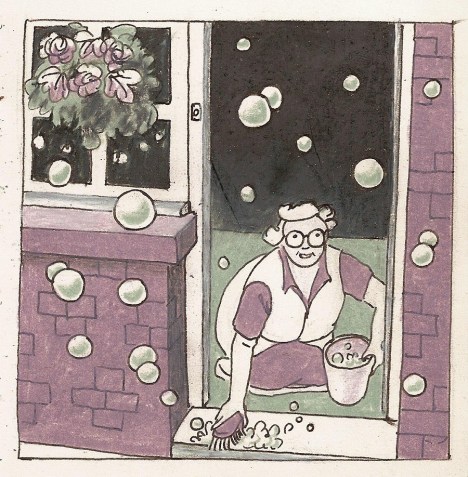
While many Westerners came to Antaiji and left soon after, a nucleus of people stayed and maintained a zazen practice at the temple. A majority of these foreigners lived in Gentaku, the name of the neighbourhood surrounding the temple. Though most of us had our own apartments and private lives, a loose community did develop. For many of us who questioned the conventional lives of the people in the worlds we left behind, it was the first time to feel some sense of being settled — a sense that came primarily from the sitting practice we shared at Antaiji. Many felt that they were doing something constructive for the first time. This group of people who previous to their arrival at Antaiji felt out of place in the world now generated considerable excitement and creative energy.
We sat the sesshins; there was no reason to be at Antaiji if you didn’t. Sesshins were the core, the heart of the practice. Zazen was the hub and sesshins were the centre of the hub. You felt like a bona fide member of the Zen world when you sat sesshin. It didn’t matter how much your mind wandered or how much your body reeled, if you sat sesshin you were a member in good standing. I was lucky to have sat my first three sesshins while living at Antaiji. If you lived at the temple, you were required to sit the full sesshin. I got used to sitting full sesshins before I had any choice and never allowed myself to choose otherwise when I was free to. Once I had acquired the habit of sitting, I had no desire to skip any part of sesshin. My obsession to sit every hour might even be seen as neurotic. Whatever the reason, I am grateful for having got into the habit. I imagine sitting must feel interminable when you know you can leave at any time and are constantly battling with that possibility.

Uchiyama knew that many of those who lived outside of the temple had full-time jobs. If he required all to commit to sit the whole sesshin, many wouldn’t be able to participate at all. His policy resulted in a zendo crowded in the evenings and on the weekends and much emptier during the week. The changing cast may have been a distraction to those who sat throughout, but since it was the result of an effort to allow as many as possible to practice, it felt right.
The zazen culture promoted at Antaiji energized us and spurred us on. It may have also deferred the feeling of smallness that I believe eventually hits all who continue sitting sesshins. You can feel pretty important after sitting a sesshin, especially when you hear all the monks calling it “the essence of Zen.” The belief that you will feel something very special at some point during sesshin can keep you high with anticipation for quite a while, but when after many sesshins your expectations aren’t fulfilled, you start to wonder what you are doing sitting all those hours on your black cushion. At some point (if you continue) you drop those expectations, and with them you drop that feeling of expectation, which is really no more than self-importance, too.
These intensive meditation retreats, though somewhat mechanical themselves, seem to be designed to awaken you from mechanical, unaware existence. Long and consecutive days of intensive zazen require new ways of dealing with physical and mental pain, boredom, and fear. The feeling of desperation, resulting from growing leg and back pain on the physical level and from boredom and racing thoughts on a mental level, can eventually trigger the body to overcome these physical and mental obstacles. I’m sure that similar experiences occur wherever one sits sesshins; Uchiyama, however, had a particular style that encouraged us to fall back on our own resources to deal with the personal hardships that sesshin presented. Though each Japanese Zen teacher has a personal style recognizable in sesshin, he usually stays pretty close to prescribed traditional structures. Uchiyama was unique in this respect, creating structures that were quite modern. He felt that with the exception of zazen itself, dependency on forms or on teachers was a trap that would ultimately prove harmful to his students.
Sesshin started at four in the morning. We would pass through two big wooden doors that squeaked loudly when opened or closed and go to our cushions. Uchiyama would enter quietly, with no ceremony, and go to his cushion and sit. By 4:10 everyone was seated on their cushions and, creaking stridently, the main doors were shut as a large drum was hit to mark the official start of the first sitting. I can still call up the mixed feeling of trepidation and exhilaration that accompanied that early morning drum beat. It was the last loud noise until the sesshin’s end. From that point on people entered and exited the zendo through a small sliding side door. The final sitting period of sesshin, days later, ended with the screeching sounds of the main door opening again.

The long sittings, the relative lack of ceremony, and, for some, the feeling of a lack of support sent people looking for other places to practice. But those were also the very things that kept those of us who stayed at Antaiji. We thought we were being supported without being smothered, and that suited our temperament just fine. Everyone was welcome to stay for meals and spend the night during sesshin. The meals were simple and wonderful, cooked by Joshin, the only resident nun at Antaiji. This woman’s devotion to feeding all participants, cooking on wood fires, carrying heavy tubs of rice, and remaining invisible whenever possible, struck me as a lesson in intelligent humility, more important perhaps than sesshin itself. Despite the fact that we had to endure the discomfort of eating rather quickly and sitting in Japanese traditional position, kneeling with your buttocks resting on your ankles, some part-timers would show up an hour before lunch, sit, go to lunch, sit another hour and leave — a tribute, I believe, to Joshin’s wonderful meals. The meals were eaten quickly and people conducted themselves quietly, but not as quietly as at sesshins at most other Japanese temples. Bowls clacked as new people unsuccessfully tried to quietly place them on the table in front of them or to noiselessly stack them inside each other and wrap them in the formal way. As Uchiyama often said, “Quiet comes when your mind slows down enough to hear the noise.” It was not uncommon for him to compare life at Antaiji with life at other Zen monasteries. “At other temples,” he would say, “you are told to make sure your sandals are neatly lined up with the other sandals. At Antaiji, through your sitting practice you start to notice when things are out of order. At other temples, you are told to keep from making noise with your lacquered eating bowls. At Antaiji, through your sitting practice, you start to hear the noise and then stop creating it.” One more aspect of the sesshins that made Antaiji feel different than other temples was the lack of emphasis on the role for individual satori or kensho. Everyone who stayed with the sesshins at some point had something that could be interpreted as a breakthrough. On the second day of my second sesshin, just when I started to wonder whether I could physically make it through the entire five days, a feeling of desperation gave way to one of comfort bordering on elation. The physical pain disappeared and I experienced a semi-euphoric state. I even remember worrying that my legs might be permanently damaged, since they no longer ached. The rest of the sesshin for me was simply enjoying this tranquil state. When I mentioned this to Lew, who had over a year of Antaiji sesshin experience at that time, he said with a sardonic smile, “Don’t worry, the pain will come back.” And it did.
In my seven years at Antaiji that followed, I never again experienced a sesshin as physically exhilarating and as painless as that second sesshin. When people would relate their feelings of elation during zazen to Uchiyama, wondering whether they had experienced some degree of satori, he would tell them to check the weather outside at these times — implying that the elation they experienced was simply the body’s response to the good weather. Uchiyama’s physical frailty may have made him particularly susceptible to changes in weather, and he may have been oversimplifying, but I also believe he was trying to help us see that these experiences of elation had mundane, rational explanations, and the quicker we accepted this the quicker we could learn what zazen really has to teach.
So what is it zazen had to teach? Five days of sitting with, in Uchiyama’s words, “no toys,” can get quite boring, once the pain in your legs and back subsides. We try to deal with boredom during sesshin the same way we deal with it at other times — through some kind of escape. But there aren’t many escape hatches during sesshin. Whatever you do in order to escape the boredom — thinking of the next meal, planning what you will do after sesshin, and so forth — you see yourself doing it. You become more aware of how you operate in a state of mental discomfort such as boredom. The sesshin both intensifies our mental activities and feelings and minimizes the distractions that normally obscure them, so that inevitably we see them for what they are — a result not as exotic as I expected at the time, but infinitely more valuable in the long run.
Read more articles by Arthur Braverman here.
From Living and Dying in Zazen, Five Zen Masters of Modern Japan Arthur Braverman, Weatherhill. 2003
August 2003 Buddhism Now
Categories: Arthur Braverman, Beginners, Biography, Buddhism, Buddhist meditation, Chan / Seon / Zen

Comments